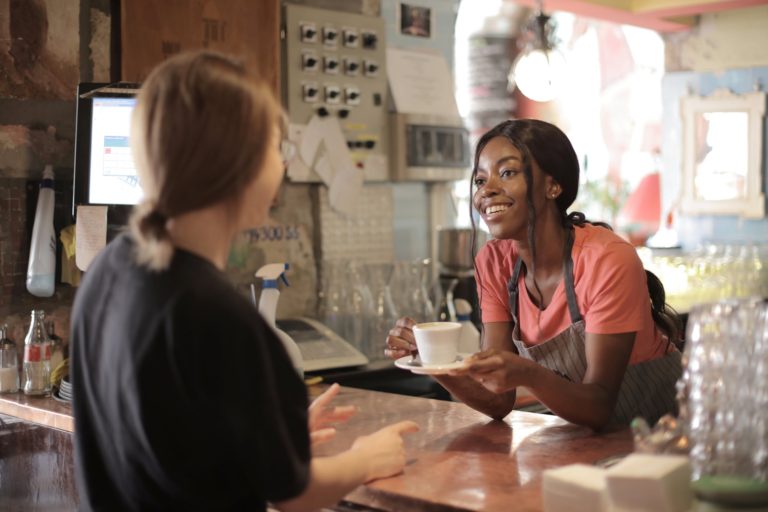When many new servers first start waiting on tables, they believe that in order to earn larger tips, they have to deliver an exceptional customer experience. The longer they work in the dining room, however, the more they come to realize that most guests have a specific tipping percentage in their heads already, and they usually stick to it unless there’s something extraordinarily good or bad about the experience (e.g. 20%). So, given that guests’ percentages are more-or-less fixed, the only consistent way to earn a bigger tip is to sell more. A larger guest check means more money for the server, too. That means suggestively selling appetizers, meal add-ons, non-refillable drinks, and desserts. Mention these options early and often, and watch your tips go up.
The truly clever eventually realize that suggestive selling is a kind of amazing customer eperience all its own, as it demonstrates a level of care and a dedication to the diners’ overall experience.
Everyone Is Getting in on It
What’s interesting is that Shep Hyken recently opined on how out-of-hand tipping culture is getting in his recent blog, “Tipping Used to Be for Good Service.” He explains a phenomenon I think most of us have seen: more and more businesses are putting tip lines on their receipts for services that have never been considered to be tip-worthy. For example, Hyken explains, “People used to tip servers at restaurants, taxi drivers, hotel staff and other traditional service-oriented businesses. Now customers are being asked to tip at auto shops, retail outlets and more.” He goes on to cite a personal example in which he recently bought a candy bar and paid using the store’s self-service checkout: “I was surprised there was an option to leave a tip for the candy bar that I picked out and paid for on a self-service machine.”
Obligation
Hyken refers to this phenomenon as tip creeping—that is, when all-new industries have started placing tipping expectations on their customers. And while these tip lines are optional (they always have been, right?), Hyken reminds us that tipping “has become, at least for some businesses, perceived as an obligation, regardless of how good or bad the experience is.” He believes this situation will escalate into a big problem as more and more businesses “force the obligation to tip on the customer.” The risk, of course, is souring the customer-business relationship by putting an expectation for more money than the sticker says.
Combine all this with another phenomenon, which Hyken calls tipflation—that is, the rising amount someone is supposed to tip. Where once 15% was the standard for good service, now 20% is often perceived as the minimum. Many establishments are placing far higher percentage suggestions on their receipts or in the checkout options.
Paying the Employees’ Wages
There’s been a lot of debate about tipping culture in America. There are some who believe that customers should not be responsible for paying employees’ wages. (Of course, if they think it all the way through, they’d realize that shopping at a store or dining at a restaurant is exactly what pays the employees’ wages!) These anti-tippers usually mention how other countries pay their employees a living wage, so tipping is rare and rarely expected.
How much of that is true depends on where you go. Tipping is still relatively common in the United Kingdom, and nearly unheard of in Japan. Frankly, it’s a bigger debate than we’re going to settle here on this blog. One thing is true, though, regardless of where you fall on the subject of whether tipping should be expected at restaurants: On average, customer service at American eateries is much better than most of its counterparts throughout the world. At least some of that is attributable to the fact that servers know they’ll make more money if they do their jobs well.
Should You Obligate Your Customers to Tip?
If you don’t operate a restaurant, taxi company, hotel, or other traditional service-oriented business, the answer is probably no. That doesn’t mean you should have a policy that employees have to refuse tips—if a customer wants to tip someone for good service, who are you to butt in? But there shouldn’t be an expectation implied in non-service-oriented industries.
As Hyken concludes, his research “finds almost half of American consumers are willing to pay more for good service. That means they will probably tip, too—when it’s deserved.” In other words, let it happen naturally. Don’t risk subtly irritating your customers when it’s otherwise inappropriate, like at a self-service gas station.
Wrapping Up
To bring this all around to where we started, it’s not all-bad that a server’s initial instinct is that he or she has to deliver exceptional customer service. While it’s true that that a larger guest check has more bearing on that particular tip, exceptional customer service is he or she wins the loyalty of your customers. That means a bigger tip now, and additional opportunities in the future.
Does your business have a strong relationship with its customers? Have you made certain you’re not making your patrons feel awkward, embarrassed, or obligated when it doesn’t make sense? And do your employees understand the long-term value of providing a great customer experience, beyond a short-term benefit like a tip or commission?
The Brandt Group will help you figure that all out. With our world-class mystery shopping services, employee and customer feedback survey tools, leadership classes, and more, let’s work together to ensure your business distinguishes itself from the competition the right way, and for the right reasons. We should already be talking! Message us today!



